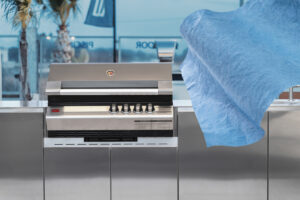In recent years, outdoor kitchens have become a rapidly growing trend, offering not only a practical solution for cooking outdoors but also an ideal space for socializing and enjoying the nice weather.
An often overlooked but crucial element when designing an outdoor kitchen is the sink. In this article, we will explain why every outdoor kitchen should have a well-designed sink and guide you in choosing the best model for your needs.
From functionality to sustainability: why adding a sink to your outdoor kitchen is always a good idea
There are several reasons why adding a sink to your outdoor kitchen is always a good idea. Let’s explore them together.
Functionality and convenience
A sink in an outdoor kitchen adds an irreplaceable level of practicality. It allows you to wash fruits, vegetables, and utensils without having to constantly go in and out of the house. Additionally, it reduces the risk of cross-contamination, keeping food and kitchen utensils clean and safe.
Cleanliness and hygiene
Maintaining hygiene is crucial when cooking outdoors. A sink offers immediate access to running water, making it easy to frequently wash hands, surfaces, and utensils. This helps prevent the spread of bacteria and ensures that food is prepared in optimal hygienic conditions.
Versatility
The sink can be used for a variety of purposes beyond simple washing. It is ideal for safely thawing foods, filling large pots, or even as a drainage point for cooking water. This versatility makes it an indispensable element in any well-designed outdoor kitchen.
Aesthetics and design
In addition to functionality, a sink can contribute to the overall aesthetics of the outdoor kitchen. Modern outdoor sinks are available in a wide range of materials and designs, from classic stainless steel to natural stone, which can seamlessly integrate with any outdoor decor style.
Added property value
Investing in an outdoor kitchen complete with a sink can significantly increase the value of your property. This additional space not only makes the home more attractive to potential buyers but can also be a deciding factor in choosing one property over another. Well-equipped outdoor kitchens are increasingly in demand and can offer a considerable return on investment.
Water consumption and sustainability
A well-designed sink can also contribute to more sustainable water management. Many modern sinks are equipped with water-saving systems that reduce water consumption without compromising functionality. Additionally, the used water can be easily recycled for garden irrigation, further reducing environmental impact.
Which sink to add to your outdoor kitchen: a guide to choosing
If you’ve reached this point and understood the importance of having a sink in your outdoor kitchen, keep reading; we will guide you in choosing the model best suited for your specific needs.
To get the maximum durability and functionality from your sink, you will first need to focus on the choice of material. The most commonly used are:
- stainless steel, which is corrosion-resistant, easy to clean, and offers a modern and professional look;
- natural stone, which is elegant and robust but requires more maintenance compared to steel;
- ceramic, which offers a classic and refined look but is more fragile than other materials and less resistant to weathering;
- quartz composite, a modern choice that combines durability and aesthetics, available in various colors and finishes.
You will then need to evaluate the size of the sink, which should be proportionate to the available space, and the type of configuration that best suits your needs. You can choose from:
- a single-basin sink, which offers ample space for washing large pots;
- a double-basin sink, perfect if you need more flexibility, as it allows you to wash and rinse simultaneously;
- a corner sink, to optimize space, especially if your kitchen layout is particularly complex.
Finally, don’t forget to consider purchasing some additional elements that could enhance the use of your outdoor kitchen. Carefully evaluate:
- pull-out spray faucets, which facilitate washing large utensils and cleaning the sink;
- integrated cutting boards, which can be placed over the sink to optimize the workspace;
- water filtration systems, useful for ensuring clean and safe water, particularly important if you use the sink water for cooking.
As you can see, integrating a sink is a fundamental step in designing your outdoor kitchen. However, the installation can be complex and may require professional intervention. Make sure you have adequate access to plumbing, and once the sink is installed, clean it regularly with products specific to the chosen material and ensure that faucets and accessories are always in good condition to avoid water leaks. With these small precautions, the sink will not only improve the functionality and hygiene of your outdoor kitchen but will also enhance its aesthetic and practical value.






